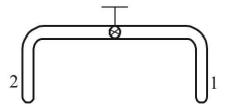1.
The diagram shows stress $$v/s$$ strain curve for the materials $$A$$ and $$B.$$ From the curves we infer that :
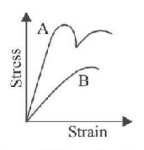
A.
$$A$$ is brittle but $$B$$ is ductile
B.
$$A$$ is ductile and $$B$$ is brittle
C.
Both $$A$$ and $$B$$ are ductile
D.
Both $$A$$ and $$B$$ are brittle
Answer :
$$A$$ is ductile and $$B$$ is brittle
2. If the ratio of radii of two wires of same material is $$3 : 1$$ and ratio of their lengths is $$5 : 1,$$ then the ratio of the normal forces that will produce the same extension in the length of two wires is
A.
$$2:1$$
B.
$$4:1$$
C.
$$1:4$$
D.
$$1:1$$
Answer :
$$1:1$$
3.
A glass tube of uniform internal radius ($$r$$) has a valve separating the two identical ends. Initially, the valve is in a tightly closed position.
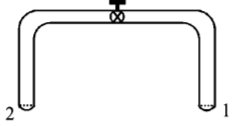
End $$1$$ has a hemispherical soap bubble of radius $$r.$$ End $$2$$ has sub-hemispherical soap bubble as shown in figure. Just after opening the valve,
A.
air from end $$1$$ flows towards end $$2.$$ No change in the volume of the soap bubbles
B.
air from end $$1$$ flows towards end $$2.$$ Volume of the soap bubbles at end $$1$$ decreases
C.
no changes occurs
D.
air from end $$2$$ flows towards end $$1.$$ Volume of the soap bubble at end $$1$$ increases
Answer :
air from end $$1$$ flows towards end $$2.$$ Volume of the soap bubbles at end $$1$$ decreases
4.
A body $$B$$ is capable of remaining stationary inside a liquid at the position shown in Fig. (a). If the whole system is gently placed on smooth inclined plane (Fig (b)) and is allowed to slide down, then $$\left( {0 < \theta < {{90}^ \circ }} \right).$$ The body will
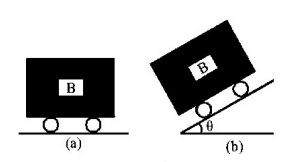
A.
move up (relative to liquid)
B.
move down (relative to liquid)
C.
remain stationary (relative to liquid)
D.
move up for some inclination $$\theta $$ and will move down for another inclination $$\theta $$
Answer :
move up for some inclination $$\theta $$ and will move down for another inclination $$\theta $$
5.
The system is rotated with angular speed $${\omega _0}$$ (see figure). What is the ratio of energy stored in each wire ?
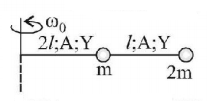
A.
$$31:9$$
B.
$$50:9$$
C.
$$47:9$$
D.
$$8:9$$
Answer :
$$50:9$$
6. A platform is suspended by four wires at its corners. The wires are $$3m$$ long and have a diameter of $$2.0\,mm.$$ Young’s modulus for the material of the wires is $$1,80,000\,MPa.$$ How far will the platform drop (due to elongation of the wires) if a $$50\,kg$$ load is placed at the centre of the platform?
A.
$$0.25\,mm$$
B.
$$0.65\,mm$$
C.
$$1.65\,mm$$
D.
$$0.35\,mm$$
Answer :
$$0.65\,mm$$
7. When a force is applied on a wire of uniform cross-section area $$3 \times {10^{ - 6}}{m^2}$$ and length $$4m,$$ the increase in length is $$1\,mm.$$ Energy stored in it will be $$\left( {Y = 2 \times {{10}^{11}}\,N/{m^2}} \right)$$
A.
$$6250\,J$$
B.
$$0.177\,J$$
C.
$$0.075\,J$$
D.
$$0.150\,J$$
Answer :
$$0.075\,J$$
8. A large number of droplets, each of radius, $$r$$ coalesce to form a bigger drop of radius, $$R.$$ An engineer designs a machine so that the energy released in this process is converted into the kinetic energy of the drop. Velocity of the drop is ($$T$$ = surface tension, $$\rho $$ = density)
A.
$${\left[ {\frac{T}{\rho }\left( {\frac{1}{r} - \frac{1}{R}} \right)} \right]^{\frac{1}{2}}}$$
B.
$${\left[ {\frac{{6T}}{\rho }\left( {\frac{1}{r} - \frac{1}{R}} \right)} \right]^{\frac{1}{2}}}$$
C.
$${\left[ {\frac{{3T}}{\rho }\left( {\frac{1}{r} - \frac{1}{R}} \right)} \right]^{\frac{1}{2}}}$$
D.
$${\left[ {\frac{{2T}}{\rho }\left( {\frac{1}{r} - \frac{1}{R}} \right)} \right]^{\frac{1}{2}}}$$
Answer :
$${\left[ {\frac{{6T}}{\rho }\left( {\frac{1}{r} - \frac{1}{R}} \right)} \right]^{\frac{1}{2}}}$$
9.
Water is filled in a cylindrical container to a height of $$3m.$$ The ratio of the cross-sectional area of the orifice and the beaker is $$0.1.$$ The square of the speed of the liquid coming out from the orifice is
$$\left( {g = 10\,m/{s^2}} \right)$$
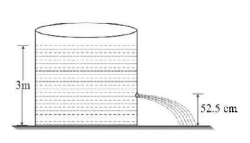
A.
$$50\,{m^2}/{s^2}$$
B.
$$50.5\,{m^2}/{s^2}$$
C.
$$51\,{m^2}/{s^2}$$
D.
$$52\,{m^2}/{s^2}$$
Answer :
$$50\,{m^2}/{s^2}$$
10. To break a wire, a force of $${10^6}\,N/{m^2}$$ is required. If the density of the material is $$3 \times {10^3}\,kg/{m^3},$$ then the length of the wire which will break by its own weight will be
A.
$$34\,m$$
B.
$$30\,m$$
C.
$$300\,m$$
D.
$$3\,m$$
Answer :
$$34\,m$$
